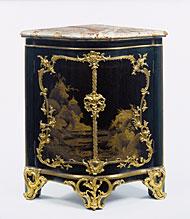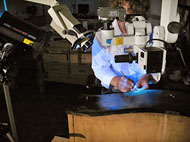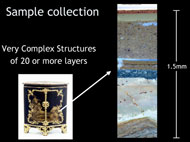Protocol for Sampling Individual Lacquer Layers

|
|
An important component of the research was the development of a procedure for sampling individual lacquer layers for analysis. Isolation of sample material from a single layer made it possible to definitively identify the materials present in each layer, which is of utmost importance considering the complex layering structure of lacquers. If the layering structure had been ignored during sampling, the analytical results would reflect the bulk composition, thereby missing the subtle compositional differences between layers.
Physical sampling of the lacquer for analysis is preceded by careful examination to ensure that the sample site is well preserved and representative of the object as a whole. Areas beneath gilded mounts afford excellent sampling locations on furniture because the sample locations will be covered once the mounts are reattached, plus the mounts protect the lacquer from abrasion as well as light damage.

|
|
Promising sample sites are identified during examination under a stereomicroscope. Next, these areas are examined under ultraviolet (UV) light and imaged by X-radiography to reveal modifications and restorations that are not otherwise detectable. After identifying well-preserved and representative sample sites, samples are taken for visible and UV cross-section microscopy. These yield a clear understanding of the layer structure at the sample site, including the number, appearance and thickness of original and restoration layers present. Ideally, sampling for organic analysis is done in situ, directly adjacent to the cross section sample site.
The complete sampling protocol is available for downloading in PDF (1page, 61KB).
 |
Page updated: September 2010
|
||||||||||||||